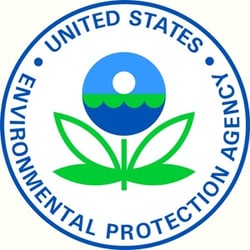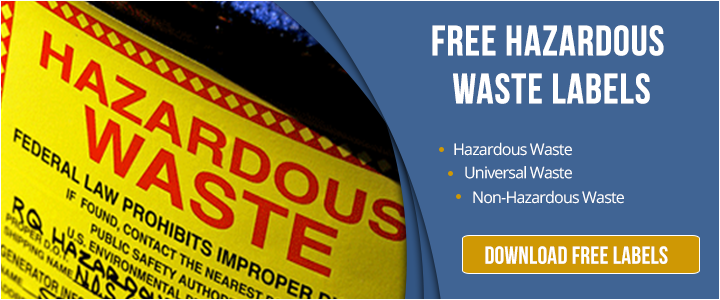Hazardous waste stickers help protect employees and waste handlers from dangerous situations that can bring harm onto themselves or others.
Without the right stickers that properly label the hazardous waste that is inside a container, individuals may be exposed to corrosive, toxic and ignitable materials … without even knowing so. This can lead to disastrous consequences for anyone in the vicinity and for the business that could be found liable for negligence.
If your business generates hazardous waste, you have a legal responsibility to properly label the waste. Yet, one of the most frequent violations issued occurs when a company does not follow hazardous waste label requirements.
Cutting corners by not placing hazardous waste stickers or labels on containers is an easy way to turn a relatively inexpensive purchase into an expensive decision. Look no further than the case involving three Southern California-based companies.
 In December 2019, the U.S. Environmental Protection Agency (EPA) announced it had fined Dura Coat Products Inc., International Aerospace Coatings Inc. and Goodwest Rubber Linings Inc. a total of $170,000 for alleged waste management violations. Among these violations was an infraction for improperly labeled hazardous waste containers.
In December 2019, the U.S. Environmental Protection Agency (EPA) announced it had fined Dura Coat Products Inc., International Aerospace Coatings Inc. and Goodwest Rubber Linings Inc. a total of $170,000 for alleged waste management violations. Among these violations was an infraction for improperly labeled hazardous waste containers.
Below we will explore the do’s and don’ts of hazardous waste stickers, exploring what you should know when choosing a label and important information about where these stickers should be placed on hazardous waste containers.
DO Use Stickers That Include Detailed Information
Although there are stickers you can purchase that simply read “hazardous waste,” these should only be used in conjunction with more thorough hazardous waste label stickers that have space for more information … NOT in place of these more detailed labels.
As we will further explain below, there are several other pieces of information that must be included on a hazardous waste label, and a sticker stating hazardous materials are present inside a container is simply not enough information.
When waste is first placed in the container is when a label should be applied to the container.
DON’T Forget ALL The Required Information
The California Department of Toxic Substances Control (DTSC), Department of Transportation (DOT) and Environmental Protection Agency (EPA) all have their own set of requirements that hazardous waste generators must follow when it comes to the information required on stickers or labels.
Our article, Hazardous Waste Label Requirements You Need To Know, provides further details about each of these agencies and what they require.
In general, however, here is some of the information that should be included on hazardous waste stickers:
- Composition, physical state and identification of the waste
- Statement or statements that call attention to the hazardous properties of the waste
- Name and address of the generator
- Generator’s EPA identification number
- Manifest tracking number
- Initial accumulation date of waste
It is also important to note that when waste is only permitted to be held in a container for 90 days, containers used by a generator to collect or consolidate wastes initially accumulated in other containers are subject to the same labeling requirements. That means the initial accumulation and “90-day period” dates on the “collection” container/tank must be the oldest of the initial accumulation.
“Recurring use” labels may be used on containers that are continuously reused for accumulation of the same waste stream, though the initial accumulation date recorded on the sticker must be updated when the containers are emptied. If the container is emptied each day, the word “daily” may be used on the date area of the label.
DO Use The Same Method When Labeling The Stickers
 It is important for a company to have a protocol in place when it comes to filling out the hazardous waste stickers. For example, one protocol may be to always use prepared labels versus handwritten labels.
It is important for a company to have a protocol in place when it comes to filling out the hazardous waste stickers. For example, one protocol may be to always use prepared labels versus handwritten labels.
Handlers should never use abbreviations to ensure there are no misunderstandings about the content inside the containers, and waste handlers should all undergo proper training to ensure all employees are trained on how to fill out the labels.
DON’T Place Stickers In Poorly Visible Spots
Before placing label stickers, remove any old labels if reusing containers, and make sure all old markings or stickers are washed off or blackened out.
The DOT also requires that labels be properly placed on the container so that they are not missed by handlers. The labels must appear in their entirety. Workers should not place them near any other markings on the surface.
To avoid being missed, never place labels near or on the bottom of a container.
If multiple labels are required, place the labels 6 inches apart. Place the primary hazard above and to the left of the subsidiary hazard label.
DO Get Assistance
Failure to follow federal and state guidelines for hazardous waste labels can lead to costly fines and dangerous consequences for workers. If you are not sure of your responsibilities nor sure of the proper way to display hazardous waste stickers on your containers, it is important to get expert help to ensure you are compliant.
A certified hazardous waste disposal company will help ensure all hazardous waste label requirements are met, as well as your correct classification as either a small or large quantity generator. This status can mean different requirements for your hazardous waste storage liability and the process by which you label your hazardous waste.


Comment